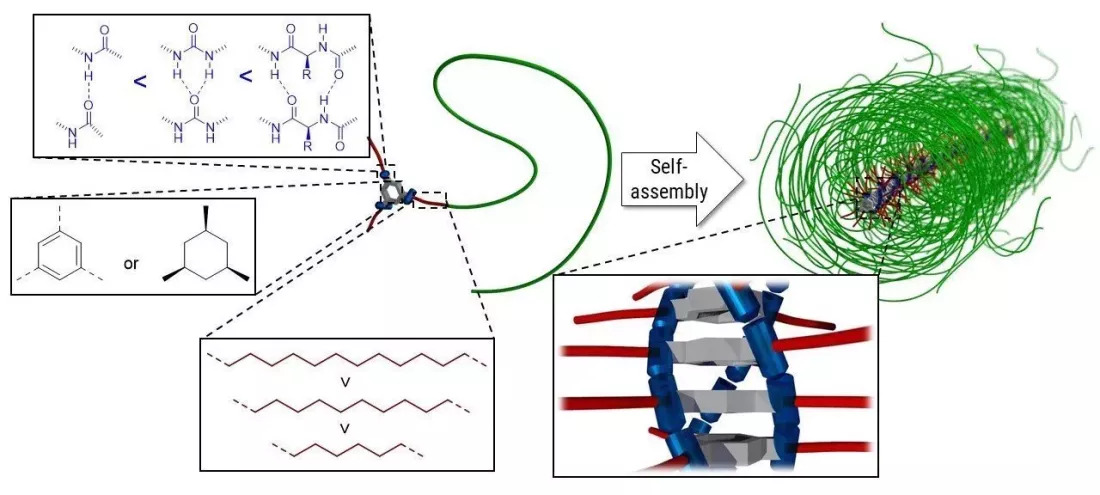Supramolecular structure formation
Anisotropic structuring of polymers using supramolecular interactions
Hydrogen bond-forming building blocks as core motif
To produce supramolecular equivalents of the covalent polymer brushes it requires strong directional interactions, such as hydrogen bonds. However, single groups are not sufficient for this and a synergistic combination of several parallel units, e.g. amide or urea groups, is required to realize a sufficient bond strength, which counteracts the steric claim of the polymer chains. The central motif of our supramolecular building blocks consists of a symmetrical core (benzene or cyclohexane), which is substituted in 1,3,5-position with different hydrogen bond forming groups (e.g. amides, ureas or short peptides). The large variability in the number of hydrogen bonds allows to adjust the strength of the interaction and thus to influence the aggregation. Hydrophobic segments, mostly alkyl chains, also allow assembly in water, as they shield the hydrogen bonds from surrounding water molecules. Finally, by linking polymer chains, supramolecular polymer brushes can be generated in solution.

Structure of supramolecular polymer brushes (Illustration: Johannes C. Brendel)
Dynamic and control over aggregation
While a number of structures capable of forming supramolecular polymer brushes are already known, control of aggregation has so far only been achieved to a limited extent. Of central importance here is the dynamics in these assemblies, i.e. how quickly individual components can exchange or break and form new hydrogen bonds. A central goal of our work is to establish more detailed relationships between the structure and dynamics of supramolecular polymer brushes. For this purpose, we use various methods, such as spectroscopic methods to determine the speed of the exchange. Based on these dynamic investigations we should finally be able to produce defined polymer brushes of controlled length.

FRET SPB (Illustration: Johannes C. Brendel)
Synthesis of multifunctional supramolecular polymer brushes
While the basic investigations on the building blocks are carried out with comparable polymers (usually polyethylene oxide, PEO), a variety of functional units can be incorporated using controlled polymerization techniques. For example, stimuli-responsive polymers can be used to control the aggregation depending on the environment (e.g. pH). In addition, selectively incorporated reactive groups can also be used to introduce cell-specific ligands or reversibly bound active ingredients. With a better understanding of the dynamics, it is finally possible to combine differently functionalized building blocks into a multifunctional polymer brush, which can be used in nanomedicine, among other things.

Modular platform for SPB (Illustration: Johannes C. Brendel)

